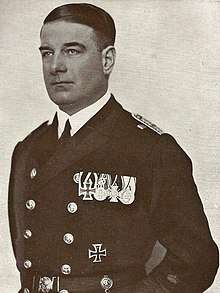Karl Spindler (naval officer)
Karl Spindler (1887-1951) was a German Naval Officer who was involved in an attempt to bring German arms ashore in Ireland on behalf of Irish rebels as part of the Easter Rising of 1916.[1]
Karl Spindler | |
|---|---|
 | |
| Born | May 29, 1887 Königswinter, German Empire |
| Died | November 29, 1951 Bismarck, North Dakota, United States |
| Allegiance | German Empire |
| Imperial German Navy | |
Early life
Spindler was born in the small town of Königswinter, near Cologne, Germany on 29 May 1887, the son of a quarry owner, Hubert Spindler, and his wife Elise (née Fuchs). At an early age Spindler decided to go to sea rather than to join the family business, serving for a period as a watch officer on a Lloyd line steamship. He subsequently enlisted in the marine school in Bremen and the naval academy in Sonderburg (now in Denmark, but then in Germany). He served on several ships of the German Imperial Navy and at the outbreak of the Great War, he was commanding the Polarstern, a guardship for the port of Wilhelmshaven.
Naval career
On 20 March 1916, Spindler was given instructions by his senior officer to undertake a highly secretive and dangerous mission on board a disguised merchant ship and to pick five officers and a crew of 16 to join him on the journey. He was given command of a vessel named Libau,[2] falsely renamed Aud, a Norwegian freighter of similar appearance. It was to carry a cargo of German arms to the west coast of Ireland along with a passenger, Sir Roger Casement, as part of a plan to assist Irish republicans in staging what would become the 1916 Easter Rising.
Spindler travelled to Berlin for further orders and met Casement. However, Casement preferred to travel onboard the submarine which would accompany the Libau. Casement was later set ashore by the submarine at Banna Strand in Co. Kerry via a small collapsible boat. However, Casement was arrested soon afterwards on Good Friday, 21 April 1916, and taken prisoner in the Tower of London on charges of High Treason against the United Kingdom. He was subsequently executed by hanging at Pentonville Prison on 3 August 1916. The uprising had failed.
Spindler's ship was intercepted by British naval vessels near the Blasket Islands and forced to sail for Cobh (then known as Queenstown) where there was a major British naval base. Spindler instructed his crew to open the ship's sea-valves and blow an explosive charge in the hold. As they left the sinking ship the crew took down the false Norwegian flag she was flying and hoisted the German Imperial flag in its place. They boarded two dinghies and were taken as British prisoners of war to Donington Hall.
From there they later escaped only to be recaptured the following day. Spindler was in a weakened state after several bouts of ill-health, and in a prisoner exchange shortly before the end of the war he was transferred to the Netherlands.
Literary works
In 1921 Spindler published a book on the "Aud" episode which was translated into English as "The mystery of the Casement ship" or "The Mystery Ship".[3] It made significant sales and was translated into several languages.
Life in the United States
In 1931, in commemoration of the 15th anniversary of the Easter Rising, Spindler was asked by the president of the Irish committee in New York to give a lecture tour in several major US cities. His tour was organised by Irish-American groups (including IRA and other revolutionary and republican members) to demonstrate the bond between the Irish and Germans. He was awarded a gold medal in a commemoration ceremony in Mecca Temple, where he gave the first speech of the tour to about 4,000 people.[4]
In California, both San Francisco and Los Angeles hosted parades for Spindler, and he was given the key to the state of California. In Boston he was given the key to the city.[5] An example of a commemorative medal from this tour can be found here.
Later life and death
Although he made several returns to Germany to see his family, Spindler remained in the United States for the rest of his life. During World War II he was detained in an internment camp as an enemy alien as he failed to get permanent residency or naturalization in the US. He was released in poor health at the end of the war. Karl Spindler died on 29 November 1951 in Bismarck, North Dakota.[6]
References
- Captain Karl Spindler, Siebengebirge e.V.
- Shipwrecks of Cork Harbour Archived 2013-06-24 at Archive.today
- German Describes Effort to Arm Irish, New York Times, 3 January 1921
- Wilk, Gavin (2014-12-01). Transatlantic Defiance: The Militant Irish Republican Movement in America, 1923-45. Oxford University Press. ISBN 9781847799500.
- "Heimatverein Siebengebirge e". www.heimatverein-siebengebirge.de. Retrieved 2019-03-08.
- Karl M Spindler, findagrave.com